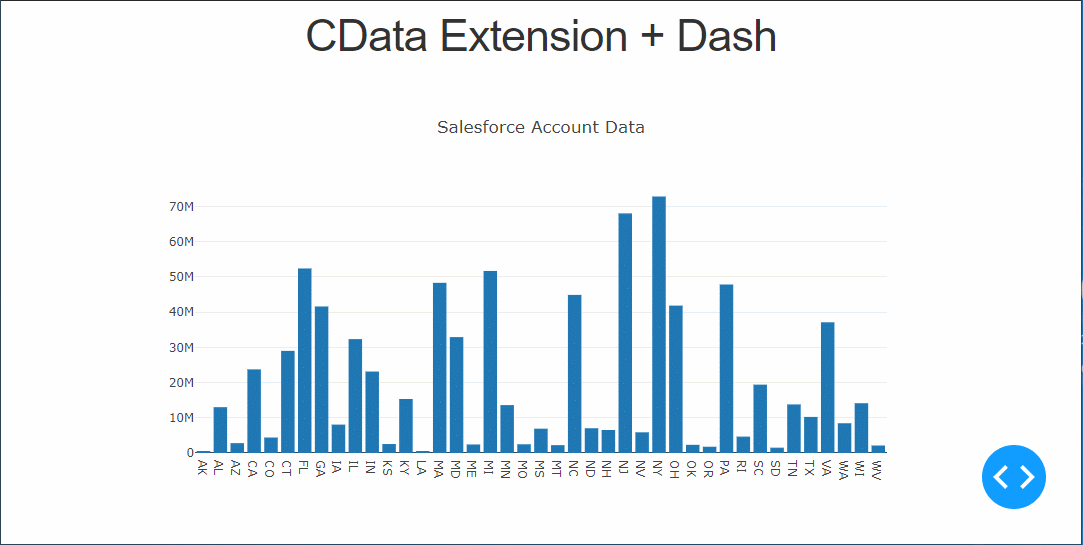Discover how a bimodal integration strategy can address the major data management challenges facing your organization today.
Get the Report →Use Dash to Build to Web Apps on Certinia Data
Create Python applications that use pandas and Dash to build Certinia-connected web apps.
The rich ecosystem of Python modules lets you get to work quickly and integrate your systems more effectively. With the CData Python Connector for Certinia, the pandas module, and the Dash framework, you can build Certinia-connected web applications for Certinia data. This article shows how to connect to Certinia with the CData Connector and use pandas and Dash to build a simple web app for visualizing Certinia data.
With built-in, optimized data processing, the CData Python Connector offers unmatched performance for interacting with live Certinia data in Python. When you issue complex SQL queries from Certinia, the driver pushes supported SQL operations, like filters and aggregations, directly to Certinia and utilizes the embedded SQL engine to process unsupported operations client-side (often SQL functions and JOIN operations).
Connecting to Certinia Data
Connecting to Certinia data looks just like connecting to any relational data source. Create a connection string using the required connection properties. For this article, you will pass the connection string as a parameter to the create_engine function.
There are several authentication methods available for connecting to Certinia: login credentials, SSO, and OAuth.
Authenticating with a Login and Token
Set the User and Password to your login credentials. Additionally, set the SecurityToken. By default, the SecurityToken is required, but you can make it optional by allowing a range of trusted IP addresses.
To disable the security token:
- Log in to Certinia and enter "Network Access" in the Quick Find box in the setup section.
- Add your IP address to the list of trusted IP addresses.
To obtain the security token:
- Open the personal information page on certinia.com.
- Click the link to reset your security token. The token will be emailed to you.
- Specify the security token in the SecurityToken connection property or append it to the Password.
Authenticating with OAuth
If you do not have access to the user name and password or do not want to require them, use the OAuth user consent flow. See the OAuth section in the Help for an authentication guide.
Connecting to Certinia Sandbox Accounts
Set UseSandbox to true (false by default) to use a Certinia sandbox account. Ensure that you specify a sandbox user name in User.
After installing the CData Certinia Connector, follow the procedure below to install the other required modules and start accessing Certinia through Python objects.
Install Required Modules
Use the pip utility to install the required modules and frameworks:
pip install pandas pip install dash pip install dash-daq
Visualize Certinia Data in Python
Once the required modules and frameworks are installed, we are ready to build our web app. Code snippets follow, but the full source code is available at the end of the article.
First, be sure to import the modules (including the CData Connector) with the following:
import os import dash import dash_core_components as dcc import dash_html_components as html import pandas as pd import cdata.certinia as mod import plotly.graph_objs as go
You can now connect with a connection string. Use the connect function for the CData Certinia Connector to create a connection for working with Certinia data.
cnxn = mod.connect("User=myUser;Password=myPassword;Security Token=myToken;InitiateOAuth=GETANDREFRESH;OAuthSettingsLocation=/PATH/TO/OAuthSettings.txt")")
Execute SQL to Certinia
Use the read_sql function from pandas to execute any SQL statement and store the result set in a DataFrame.
df = pd.read_sql("SELECT BillingState, Name FROM Account WHERE Industry = 'Floppy Disks'", cnxn)
Configure the Web App
With the query results stored in a DataFrame, we can begin configuring the web app, assigning a name, stylesheet, and title.
app_name = 'dash-certiniaedataplot' external_stylesheets = ['https://codepen.io/chriddyp/pen/bWLwgP.css'] app = dash.Dash(__name__, external_stylesheets=external_stylesheets) app.title = 'CData + Dash'
Configure the Layout
The next step is to create a bar graph based on our Certinia data and configure the app layout.
trace = go.Bar(x=df.BillingState, y=df.Name, name='BillingState')
app.layout = html.Div(children=[html.H1("CData Extension + Dash", style={'textAlign': 'center'}),
dcc.Graph(
id='example-graph',
figure={
'data': [trace],
'layout':
go.Layout(title='Certinia Account Data', barmode='stack')
})
], className="container")
Set the App to Run
With the connection, app, and layout configured, we are ready to run the app. The last lines of Python code follow.
if __name__ == '__main__':
app.run_server(debug=True)
Now, use Python to run the web app and a browser to view the Certinia data.
python certinia-dash.py

Free Trial & More Information
Download a free, 30-day trial of the CData Python Connector for Certinia to start building Python apps with connectivity to Certinia data. Reach out to our Support Team if you have any questions.
Full Source Code
import os
import dash
import dash_core_components as dcc
import dash_html_components as html
import pandas as pd
import cdata.certinia as mod
import plotly.graph_objs as go
cnxn = mod.connect("User=myUser;Password=myPassword;Security Token=myToken;InitiateOAuth=GETANDREFRESH;OAuthSettingsLocation=/PATH/TO/OAuthSettings.txt")
df = pd.read_sql("SELECT BillingState, Name FROM Account WHERE Industry = 'Floppy Disks'", cnxn)
app_name = 'dash-certiniadataplot'
external_stylesheets = ['https://codepen.io/chriddyp/pen/bWLwgP.css']
app = dash.Dash(__name__, external_stylesheets=external_stylesheets)
app.title = 'CData + Dash'
trace = go.Bar(x=df.BillingState, y=df.Name, name='BillingState')
app.layout = html.Div(children=[html.H1("CData Extension + Dash", style={'textAlign': 'center'}),
dcc.Graph(
id='example-graph',
figure={
'data': [trace],
'layout':
go.Layout(title='Certinia Account Data', barmode='stack')
})
], className="container")
if __name__ == '__main__':
app.run_server(debug=True)





